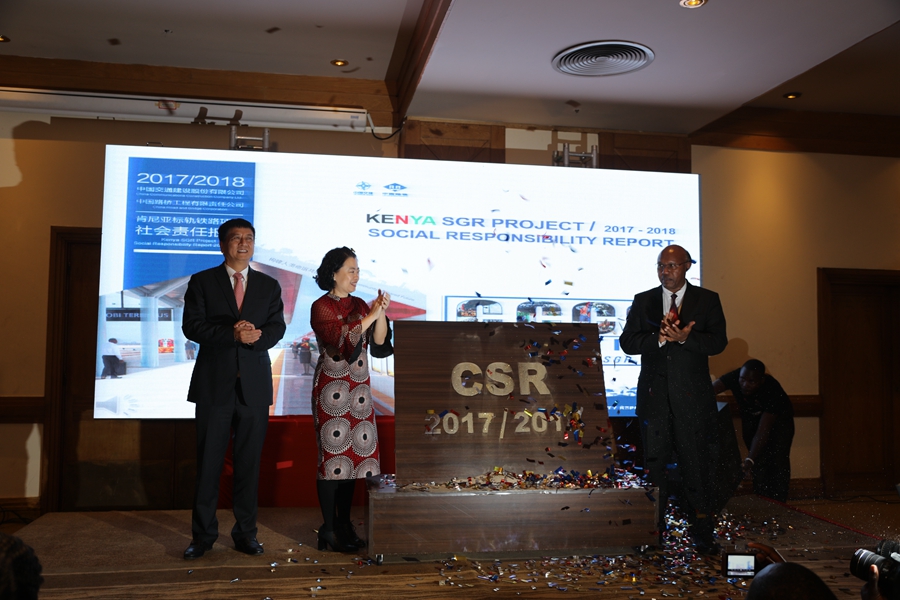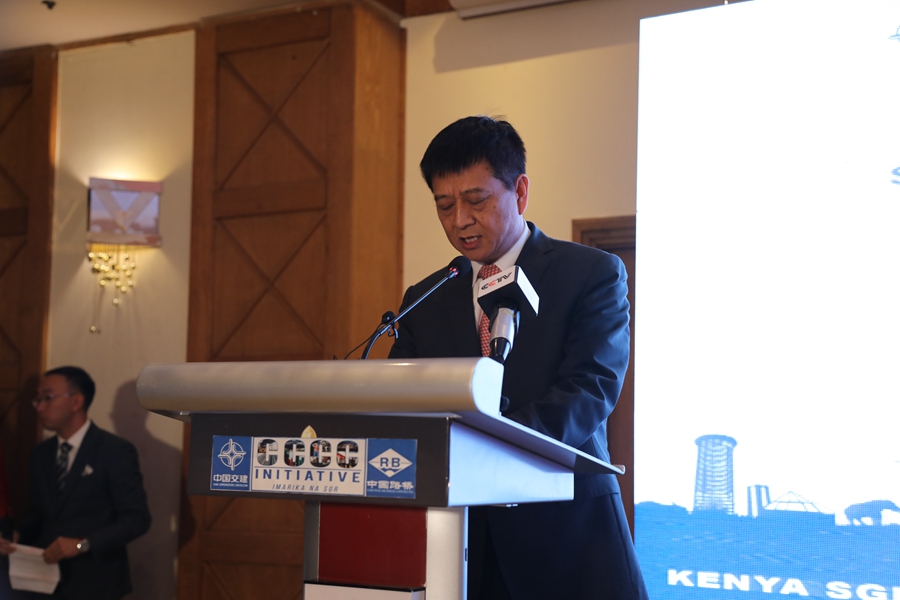Report reveals benefits of Mombasa–Malaba line to Kenya
2018-06-26 09:39:08
More than 76,000 Kenyans have so far received employment since the construction of the Mombasa–Malaba standard gauge railway line started, with more than 1,000 local suppliers contracted for various products or services, including building material, machinery and equipment.
While launching the Kenya SGR Project Social Responsibility Report 2017/2018, Lu Shan, the China Road and Bridge Corporation (CRBC) chairman, said during the construction and the passenger and freight services operations, the contractor has upheld the philosophy of sustainable development and shared prosperity.
"The SGR has generated strong momentum for social and economic development of Kenya, bringing real benefits to the locals. It has contributed to 1.5 percent to GDP growth and reduced logistics cost by 40 percent," said Lu.
For the on-going construction of the 120 km Nairobi–Naivasha SGR line, China Communications Construction Company (CCCC) has already employed 26,000 people spread across the seven branch offices and the head office.
Speaking at the launch, Sun Baohong, Chinese ambassador to Kenya, said, "I firmly believe that the SGR will play an even more important role in the development of Kenya and East Africa as a whole. The SGR is one shining example of how Chinese companies in Kenya have integrated social responsibility into their work. As Chinese President Xi Jinping stresses, while developing relations with African countries, China always adheres to principals of sincerity, practical results, affinity and good faith and upholds the values of friendship, justice and shared interests."
Paul Maringa, permanent secretary of Ministry of Transport, Infrastructure and Urban Planning, said, "Education and knowledge transfer are critical for project sustainability. The Chinese presence in our country as contractors has brought modernised systems and an exciting work culture. Scaling down a project like the SGR from 5 years to two-and-a-half years would take a very unique form of dedication. Here in Kenya we are learning that the 24-hour economy is not about energy but the commitment of the people."
"We celebrate the sharing of resources such as boreholes to provide clean water to the local residents. The engagement we have seen between CRBC and the children from AIC Kitet Primary School shows that we are achieving the bonding of hearts, not just business. We are telling the communities along the railway corridor that ours is a long-term relationship," he said.
Steve Zhao, the CCCC spokesperson said, "When the SGR Phase 2A was officially launched, we prioritized locals during recruitment, doing our utmost to boost local employment. When local employees were unable to meet construction requirements, we would employ skilled employees who had worked for SGR Phase 1 to realize the localization of technology transfer."
Technology transfer has been one of the project legacies the contractors want to leave after the construction of the standard gauge railway from Mombasa to Malaba. To promote technology transfer to local employees, CCCC has enhanced the training of local employees on their technical and management capabilities.
In addition, the contractor implemented a trainee programme over the previous year, to provide a platform for Kenyan college students majoring in engineering to learn site operations and obtain related knowledge.
The impact of the SGR Phase 1 and 2A has also been extended to local suppliers, where procurement of cement, steel, oil, as well as transport services has increased significantly. "We are currently sourcing 100 percent of the high-strength 52.5 cement locally, from 92.5 percent during the Phase 1 construction. The procurement of reinforcing bar – rebar – has also increased from 66 percent to 82 percent by the end of April 2018," added Zhao.
 Some of the key suppliers working with the project include Devki Steel Mills Limited, Savannah Cement Limited, Prime Steel Mills Limited, Hass Petroleum, Athi River Mining Cement Limited, Gulf Energy, Nitro Chemicals, Vivo Energy Kenya, Bamburi Cement Ltd, East Africa Portland Cement Co Ltd among others.
Some of the key suppliers working with the project include Devki Steel Mills Limited, Savannah Cement Limited, Prime Steel Mills Limited, Hass Petroleum, Athi River Mining Cement Limited, Gulf Energy, Nitro Chemicals, Vivo Energy Kenya, Bamburi Cement Ltd, East Africa Portland Cement Co Ltd among others.
The Kenya SGR Project Social Responsibility Report 2017/2018 has also outlined the corporate social interventions the contractor has engaged in over the past year, spread across improving access of water, education and infrastructure repair.
According to Lu, CCCC has set aside 0.5 percent of the contract amount to fund the CSR programs. "Since most of our branch offices are in remote rural areas without developed infrastructure, we have built bridges, repaired roads, built and restored houses for the locals, doing our utmost best to raise their standards of living."
In Ongata Rongai town for instance, the SGR contractor constructed a new Oletepes Bridge that was on the verge of collapsing by bringing it to modern technical standards and high enough above the river.
SGR Phase 2A also initiated the Naivasha Water Project to set up water points and towers along the project and distribute water from Lake Naivasha to local residents for their daily use (non-drinking) and livestock drinking water. Section office number 4 in Maai Mahiu also expanded a dam in Kitet village to provide water for the community's livestock during the dry season.
The CRBC chairman added that as the project progresses for Phase 2B and 2C, the firm looked forward to joining the government and Kenyan citizens in promoting sustainable economic development, to create social benefits and safeguard the environment under the Belt and Road Initiative.
